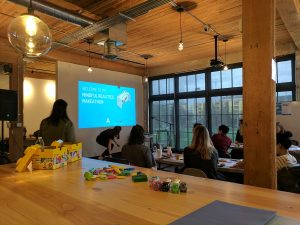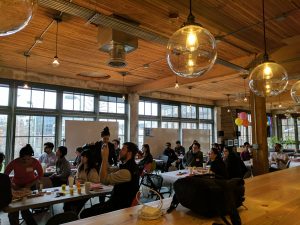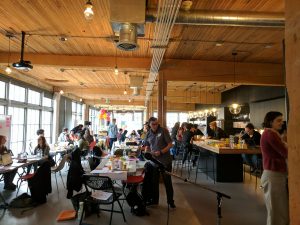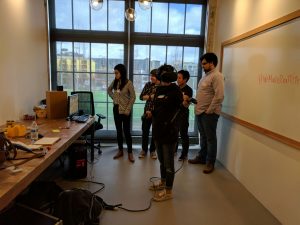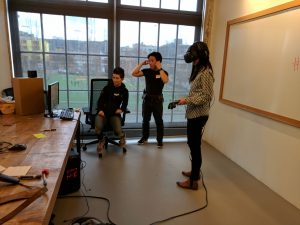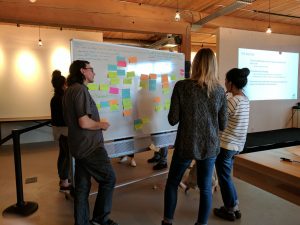Over the weekend, I was invited to mentor at a one-day event called Mindful Realities Makeathon, which was organized by @WeMakeRealities, a group formed in the wake of harassment news from recent social VR experiences, and hosted by Substantial in Seattle. Unlike other VR/AR hackathons, many of the attendees were not developers. There were researchers, artists, communicators, content designers, and other backgrounds. All of them have interest in the technology or already working in VR/AR industry. The organizers also bring in speakers from the industry, such as Stephanie Engle and Cliff Warren from Facebook, Cameron Brown from Against Grav, content designer Andrea Zeller, and many more. The main goal for this event was to come up with social VR designs that are welcoming, positive, collaborative and safe. Social VR is still a new medium, and it can change the way people connect, create and learn.
I arrived at the venue a little bit before the event started, when everyone was having breakfast. I was not sure what to expect from the event itself, and learned by ear as I got there about what to do. The attendees were already seated, and they were assigned into groups of 6 to 8 as they arrived. Each group consisted of these roles:VR creator, domain expert, communicator and researcher. VR creators were people who are familiar with current generation systems, have knowledge and can shed light on the possibilities of VR from a development standpoint. Communicators were those who enable discussions between team members to ensure everyone had a voice and a chance to speak. They also the one who would record post the team’s design by the end of the day. Domain experts were mostly mentors who have already dabbled in VR/AR development, and can provide perspective, insights or research that came from their field of expertise to the rest of the team. Researchers were people from outside of VR/AR development, who can bring different perspective to the overall design decision.
As a mentor, I floated from one team to another during discussion time to check if anyone had questions, listened to their ideas and shared with them things I knew from experience. I encountered many interesting conversations there. Some attendees have never tried VR before, and seemed to have their own preconception ideas of what it should be. Some were actually skeptic of the medium, based on past experience with older generation systems.
Around halfway of the event, we set up several machines with HTC Vive and Oculus Touch, and let each team to try social VR experience, such as Rec Room and Alt-Space. Personally I have been avoiding social VR, so for me it was a learning moment as well. I was responsible to man one of the HTC Vive station with Rec Room, and assisted those who were not familiar with the system. It was interesting to see first time users got blown away by what this tech can do, and experienced users testing available resources. While most people had a great time in VR, unfortunately one attendee actually got harassed during her in-game session. She was new to room scale VR and tried to learn the locomotion system. A few in-game players must have heard her through the microphone and decided to tail her avatar wherever she went. When she stopped moving to figure out control, they would surround her. One time she suddenly said she couldn’t see anything, that the world turned orange. From the desktop view, I saw the same thing, but it did not look like the program has crashed. The color changed as well. It turned out one for the player who surrounded her used an object like a trash can and put it over her head. Realizing what happened, I told her what she’s experiencing and asked how she feel, whether she wanted to continue or not. She decided to stop at that point and removed the headset. Me and her team spent extra time for her to make sure she was okay. Her experience was invaluable data, but at the same time we really didn’t expect anyone to have such uncomfortable experience in such a short session. I was really worried too, since this lady did not seem to be familiar with the gaming world and its history of harassment. Fortunately she was tough and after a while she felt better. We reported the incident to the organizers and they were shocked as well.
After all the team got their chance to test social VR, they went back to their table and revised their original design. By the end of the day, each group was asked to volunteer to share their ideas, about the issue they’re tackling and what solutions they came up with. All these ideas then were captured in Medium blog post to be shared with everyone on the internet. This way, hopefully developers can see these ideas and find them worth while to implement in their products for the sake of creating a more welcoming, positive and safe space in VR and AR.
You can find out more about this event at their recaps Medium post.

